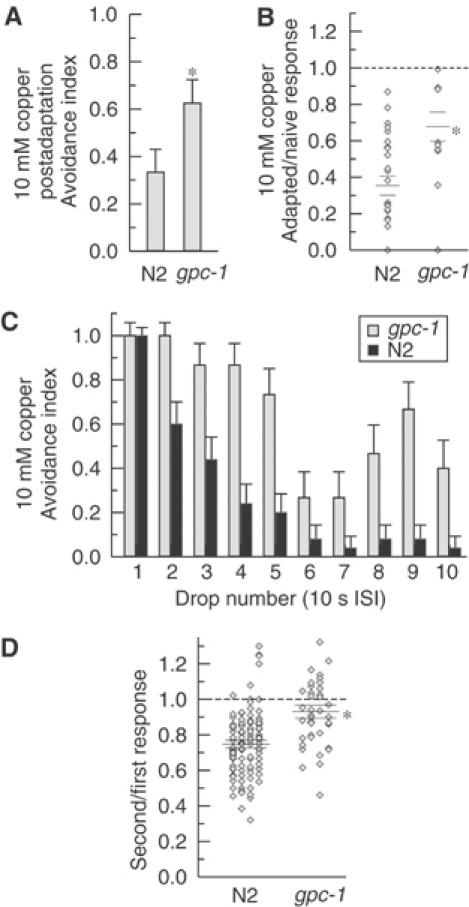Figure 6.

(A) gpc-1 animals are behaviorally defective in adaptation to prolonged repellent stimuli. Wild-type and mutants in the G-protein γ-subunit gpc-1 were tested with a copper test stimulus 1 min after a 1 min exposure to 10 mM Cu2+. gpc-1 animals show significantly less (P<0.01, asterisk) reduction of the avoidance index compared to the wild-type animals. n=24 animals for each condition. (B) gpc-1 animals are defective for ASH adaptation to prolonged stimuli. Wild-type and gpc-1 animals were stimulated before and 1 min after a 1 min exposure to 10 mM Cu2+. gpc-1 animals show significantly less reduction compared with the wild type (P<0.01, asterisk; n=10 gpc-1, n=12 N2). Ratio of second response/first response for individual trials (diamonds) and mean±s.e.m. (horizontal bars) are shown. (C) gpc-1 animals are behaviorally defective for adaptation to repeated stimuli. Wild-type and gpc-1 animals were given 10 successive 10 mM Cu2+ stimuli with an ISI of 10 s. By the second stimulus, gpc-1 animals show a significant difference from wild type (P<0.01, Fisher's exact test). n=15 animals for gpc-1; n=25 for wild type. (D) gpc-1 animals are defective in ASH adaptation to repetitive repellent stimulation. Ca2+ responses in ASH were recorded for two successive stimuli of 3 s with an ISI of 10 s. The ratio of second response to first response for individual trials (diamonds) and mean±s.e.m. (horizontal bars) are shown for the following repellents: 1 M glycerol, 10 mM Cu2+, 10 mM quinine, 0.1% SDS (columns, left to right). gpc-1 showed no significant decrease in response magnitude and was significantly different from wild type (*P<0.001).
